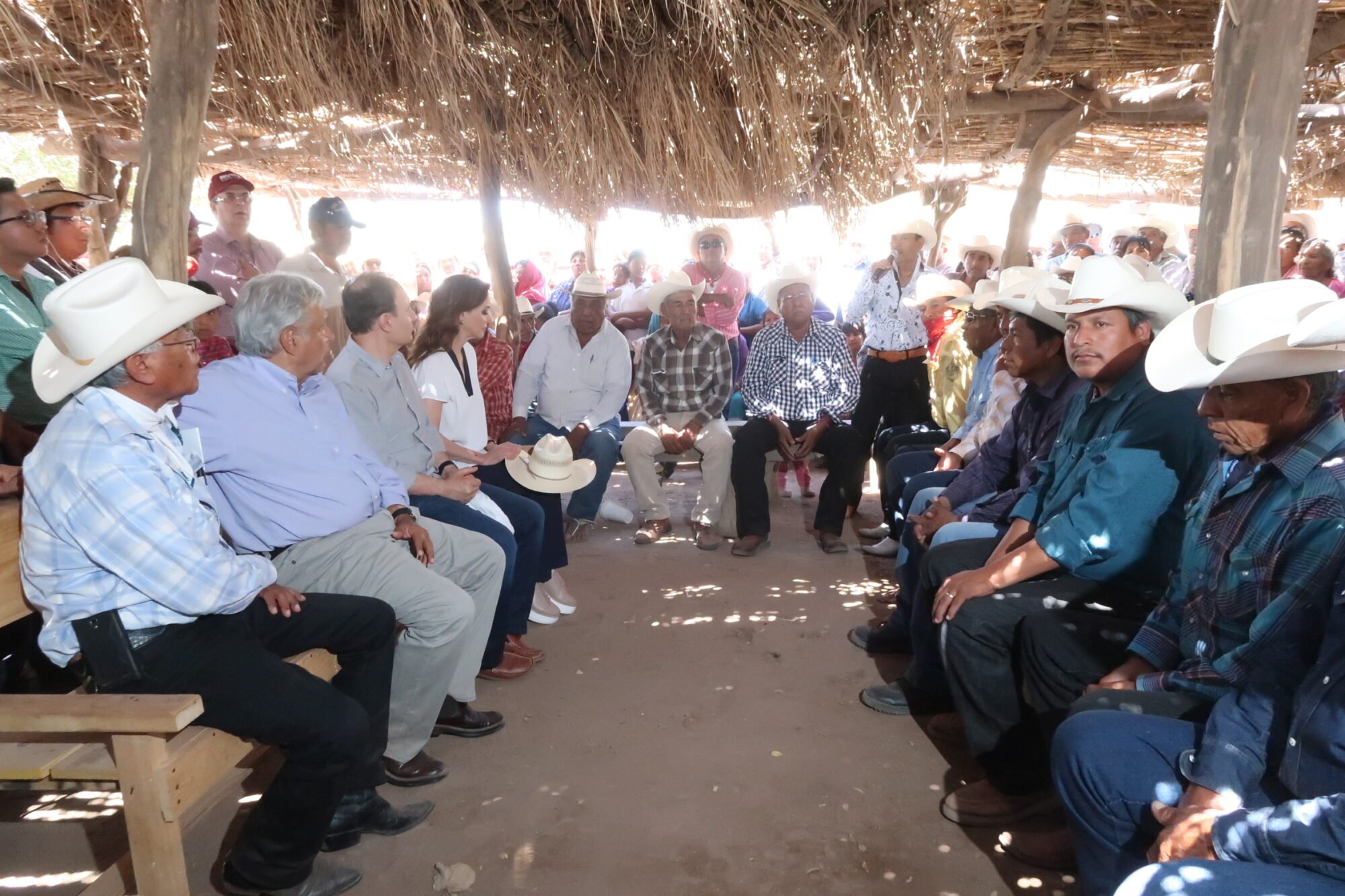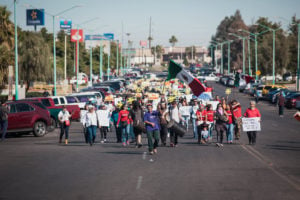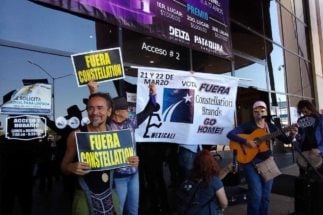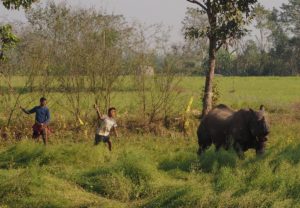The Yaqui, one of the 69 indigenous populations that inhabit Mexico, know first-hand the meaning of water injustice. An aqueduct, three reservoirs and a lack of drinking water bear testament to the cornering of this aboriginal group, made up of eight towns in the state of Sonora, northern Mexico.
Their culture and existence is tied to local water sources. Uncoupled, there is only a path towards extinction.
Tomás Rojo, whose face and voice had become a symbol of the “water war” was found dead recently, having been reported missing weeks previously and amidst a wave of violence against community leaders.
Rojo was a spokesman for the tribe and a member of the Citizen Movement for Water. He disappeared on Thursday May 27 after leaving early for a walk in his community of Vícam. He denounced the construction of infrastructure that has left the territory struggling with a drought.
Mexico’s history of water injustice
Between 1940 and 1960, the Mexican government built three dams for irrigation and electricity generation in the area. Earlier, in 1937, it awarded some 450,000 hectares to the projects and in 1940, half the flow of the Yaqui River, the biggest in the region, affording them a quota of 250 million cubic metres per year.
Another thirsty project was the Independence Aqueduct, inaugurated in 2013, with an installed capacity of 75 million cubic metres. This transfers water from the Plutarco Elías Calles dam to the city of Hermosillo, some 1,890 kilometres north of Mexico City. The transfer from the Yaqui river basin to the Sonora river aims to provide for urban growth and industry.
On top if this, the climate crisis has now hit this region that depends on seasonal rains.
“Now the problem is drought, there is a water deficit. Climate change continues to affect us. We have to be anticipating these situations, the water dispute, the effect of climate change, the deficit projections,” Rojo said in an interview prior to his disapperance.
A cocktail of threats
The conflict over water in Sonora is one ingredient in the cocktail of climatic threats to Mexico, a country of some 129 million people highly vulnerable to droughts, intense storms, floods, and rising temperatures and sea levels. There is a paradox: the south and the southeast have excess water, while the inhabitants of the centre and the north face insufficiency.
Pedro Moctezuma Barragán, general coordinator of the Sierra Nevada Research Program of the state Metropolitan Autonomous University (UAM), lists the industries responsible for excessive water use in the country: agriculture, mining, real estate, hotels, and bottling and brewing companies. Pollution, vulnerability due to droughts, floods and overexploitation of aquifers are also major problems.
“The water crisis is part of what we see every day,” he says.
Did you know…?
Mexico has 757 groundwater hydrological basins
In 2018, a group of academics submitted a study to then president-elect López Obrador. In it, they list major concerns, including the supply of water to urban centres and remote rural areas; the deterioration of the quality of rivers, lakes and reservoirs; poor wastewater management; a lack of understanding ofthe importance of groundwater; a limited vision of watershed management; and a failure to regulate access to surface and groundwater.
Esteban Castro, principal researcher at the National Council for Scientific and Technical Research of Argentina (Conicet), who has focused part of his work on the water situation in Mexico, recalls that this Latin American country has been a pioneer in identifying water-related conflicts. In 1981, there were 93 in cities.
“It was known that they were going to get worse. There are things that have not progressed and that have not been resolved, some serious. There are conflicts between rival uses of water. Mexico City draws water from several states and that generates conflicts that continue. Attempts to regulate extraction have failed in the country,” he explains.
Mexico, where water is drying up
Mexico has a land area of 1.96 million square kilometres. Of this, 67% is arid and semi-arid, and only the remaining 33% is humid. The nationwide water disparity is a reflection of its geography.
In 2018, renewable water totaled 451,585 million cubic metres, equivalent to covering the entire country with 23 centimetres of water. 67% is found in the south and southeast, 33% in the north and northeast, according to the state National Water Commission (Conagua).
Although its importance has been overlooked, groundwater is essential for Mexico, which has 757 hydrological basins, since 39% of national uses — except for hydroelectricity — depends on it.
In 2021, the country has suffered a severe drought that impacts agriculture, livestock and the availability of liquid for urban centres. Despite the start of the rainy season in May, more than half of the territory is experiencing dry conditions.
Those statistics convey a more complex picture. A regional report by the Aqueduct Alliance, a consortium of governments, companies and foundations, found that in 2017 Mexico had a high level of water stress. Throughout the Americas, only Chile has a higher degree of water stress, according to the report.
Uneven risk
From the centre of Mexico to the north, water stress is likely in 2040. Meanwhile, the northwestern corner presents a medium-high risk of aquifer depletion. And practically the entire Gulf of Mexico and the Caribbean Sea, are at a medium-to-high risk of drought.
The country’s water footprint – the impact of human activities on the resource – is estimated at 1,978 m3 / person per year. The global average is 1,385.
10million
people in Mexico lack a water supply to their homes
For Patricia Ávila, an academic at the Ecosystem Research Center at the National Autonomous University of Mexico (UNAM), it is a multidimensional problem.
“Water is the reflection of national problems. The poorest population has different access in terms of quantity and quality. That there is coverage does not guarantee that they have water. For the rural population, urban poor and indigenous areas, access is very limited. Even in the cities there is no running water every day,” she explains.
To these phenomena, Ávila adds the destruction of forests and the construction of infrastructure, as well as water pollution. “Many sources are no longer drinkable to guarantee adequate conditions for the population,” she says.
The situation in Mexico City, with more than 8 million inhabitants, is particularly delicate. It is heading for the so-called “Day Zero”, when it will run out of resources. It is third of Mexico’s 33 states in terms of water stress, behind the arid Baja California Surand Guanajuato, where agricultural activities are prevalent.
Money shortages
Austerity imposed by López Obrador in order to finance megaprojects such as an oil refinery on the Gulf of Mexico and the Mayan Train that will travel through five states in the south-southeast has adversely impacted the environment and water..
In 2019, his administration launched the “National Strategic Programme for the Knowledge and Management of Water Basins for the Common Good and Environmental Justice”, in order to investigate solutions. Of 47 listed projects, the Government will select a small group and fund them.
I don’t see changes, I don’t see a different vision. They have not internalised climate change
Another relevant proposed law is stuck in the Chamber of Deputies. So far, that institution has received six initiatives, including the first in the country drawn up by organisations that defend the human right to water, indigenous peoples, agricultural producers, and academics.
Mexico included the human right to water in its Constitution in 2012 and had one year to approve a new Water Law. The delay has now run into its seventh year. The debate around this new legislation mirrors the conflicts over the resource.
The business of scarcity
The Yaqui people wait for more than a law to have enough water.
“If the risks materialise, it will practically leave southern Sonora with a large water deficit and condemn the existence of the tribe. Perhaps a generation will have to go through the most bitter ravages, since the projection to 2030 for the Yaqui basin is a deficit of 270 million cubic metres. If you add illegal extractions, it will be more critical. They make water a very expensive commodity in Sonora, the scarcity is the business of speculators,” said Rojo.
The community and the government have already signed an agreement for the construction of an aqueduct, water treatment and sewage plants, as well as the transfer of the management of an irrigation district for some 23,000 hectares that they have de facto managed for years.
While Ávila remains hopeful that the ongoing research will help resolve the problems, he has similar reservations about the government’s stance.
“We are not sure if the government is interested in making the necessary changes or if it will be able to make them. I don’t see changes, I don’t see a different vision. They have not internalised climate change in the measures,” he says.
Only one thing seems certain. The climate crisis will make access to resources more difficult for all.
This publication is republished from a journalistic project led by Periodistas por el Planeta (PxP) and is reproduced under a Creative Commons License.







